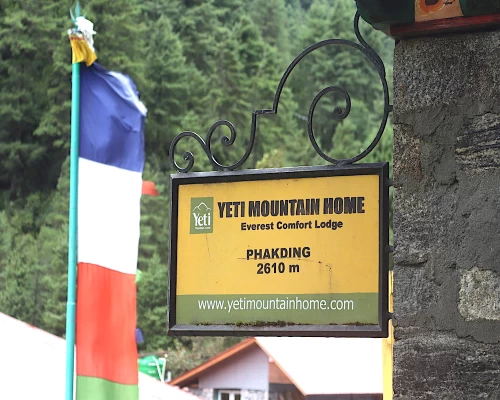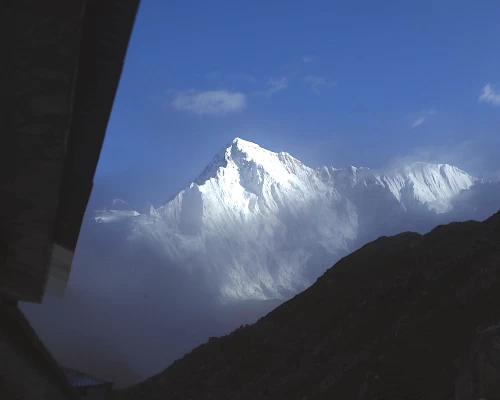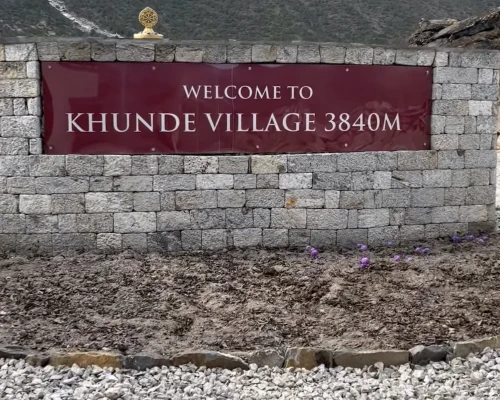Everest Luxury Kongde Trek Difficulty
The elevations in the Khumbu region are relatively high, and altitude-related health problems can occur after ascending above 2500m. Because this schedule incorporates aircraft that transport you to higher elevations rapidly, the overall difficulty of the trek is lower than, say, the complete EBC trek. The 6-7 hour walk between Phakding and Namche Bazaar is the most challenging hiking day here. The trek is primarily uphill, but you'll get your first look at Everest and pass Nepal's highest suspension bridge on this day, so it'll be unforgettable! There may be less time for acclimatization because you will travel by plane to specific locations. However, this itinerary only spends one night at a very high altitude (Kongde, 4250m), reducing the likelihood of experiencing problems with the altitude.
Best Time to do Everest Luxury Kongde Trek
The best times to visit the Everest region are during the spring (March-May) and fall hiking seasons in Nepal (September-November). This is because the days are warm, and the skies are frequently clear during these months.
No matter what time of year you take this trip, the weather will always affect your ability to fly by helicopter. For example, thick clouds during the summer monsoon might restrict flying, and snow and ice during the winter can occasionally limit landing zones. Nevertheless, helicopters can fly in situations where fixed-wing aircraft cannot.
Although they occasionally close in the summer and winter, the Yeti Mountain Home and Everest Summit lodges are open during the significant trekking season. But if you reserve your trip in advance, the clubs frequently have availability for your dates.
Food and Accommodation in Everest Luxury Kongde Trek
The Everest Base Camp Luxury Lodge Trek is the most acceptable way to see Nepal in comfort while traveling in style. Every trekker in the Everest trekking zone is welcomed by a friendly Sherpa and stays in cozy lodges with high-quality food. Trekking through lovely Nepalese villages with breathtaking views of the Khumbu and Everest region connects the opulent clubs of the Everest region.
With beautifully maintained gardens, inviting lounges and bedrooms, hot showers, and western toilets, the lodges offer the most satisfactory service far superior to anything else available in the area. The opportunity to stay at the finest local luxury lodges and experience the typical Himalayan lifestyle is the main benefit of the luxury lodge trek on Everest. Since they have panoramic views of some of the highest mountains in the world, including Mt. Everest and other snow-capped peaks, these Everest lodges are the highest luxury lodges in the world.

You can frequently select from various cuisines and food services in cities. Because it is a luxury vacation, you will stay in opulent Yeti lodges in the Everest region, and the cooking will be healthier and at your discretion. The journey will be luxuriously pleasurable with an interesting situation.
What is Luxury Trek like?
This luxury adventure vacation brings you to the Everest region, where you may experience the Everest Base Camp Trekking trail up to Tengboche and hike to nearby luxury lodges. The locations you will trek to during the journey provide breathtaking views of the Alps and tranquil natural environments. You will enjoy both the comfort of the accommodations and the spectacular vista.
This trip is suitable for hikers seeking a short but memorable trek. The Everest region, the most popular trekking region in the Himalayas, has accommodated the taste of luxury travel even when walking the mountain. When you arrive in Kathmandu, you get a taste of luxury travel in Nepal. You'll stay in one of Kathmandu's opulent five-star hotels or opulent lodges high in the Himalayas. All aspects of the trip, including the food, lodging, and travel mode, will have a hint of luxury. Additionally, the vacation will be a mix of luxury and adventure throughout.
Everest Luxury Kongde Trek Travel Insurance
No matter how challenging your trip will be in the Himalayas, getting travel insurance is always a wise choice. In a medical emergency, while traveling, we will need to fly to a hospital in Kathmandu because the area is undeveloped, rural, and devoid of basic infrastructure. Such events are improbable to occur. For your Everest Luxury Kongde Trek, we still advise
getting travel insurance to be safe. Travel insurance should cover medical expenses and emergency airlifts.
Everest Luxury Kongde Trek Cost
The Everest Luxury Kongde Trek is a pricey excursion. It's a premium excursion created to meet the unique requirements of tourists seeking an opulent adventure in the Himalayas. All luxury lodge lodging and three meals per day are included in the Everest Luxury Kongde Trek cost. In a similar vein, the price of the package also consists of any necessary permits, guides' and porters' expenses, helicopter commute costs, and other necessary land transportation.
Why Everest Luxury Kongde Trek?
Stunning vistas of the Cho Oyu, Lhotse, and Ama Dablam, as well as a prestigious trail down the west side of the valley to Kongde, are some of the highlights of this Everest Luxury trip in addition to resting in luxurious lodges. Furthermore, we spent nine days exploring the Khumbu region, where Mount Everest is located. For those who want a more expansive view of the Khumbu Valley, we even offer an optional day hiking plan to Farak Ri. One may anticipate beautiful hiking conditions on this straightforward Himalayan trek that barely reaches 5000m.
We will stop for the night at the height of 4250 meters, which is low by Himalayan standards and does not pose a risk for altitude sickness. Please be aware. Nevertheless, that walking at higher altitudes than 3000 meters is more physically demanding than walking at lower altitudes. Therefore, this luxury journey is designed for hiking at a moderate pace because hikers will need to walk for roughly a week, between three and four hours daily.
Packing List For Everest Luxury Kongde Trek
The following is the list of the things and equipment we will need to carry with us when you are heading on the journey.
1. For the upper part of the body
Hat: You'll need a nice, wide-brimmed trekking hat to keep the sun off your face. Lightweight, simple to carry, and neck-covering styles are the best. The primary reason for wearing a hat while trekking is to protect yourself from the sun while on the trail.
Headlamp: Along with the hat, carrying a headlamp with you during the trek is better. Headlamps are lights that are worn on a person's head. Due to their hands-free operation, these gadgets are great for trekking and hiking. Having your hands free when hiking is ideal for dealing with anything Mother Nature throws at you or pulling your stuff. For example, at night, trails can be hard to navigate. These footprints generally incorporate pebbles, tree roots, twigs, and even animals and resemble an uncharted maze. These hazards can be dangerous, and having your hands free allows you to catch yourself, move obstacles, sprint, or fend off an enraged rabbit on the track.
Woolen Hat: When you move to higher elevations, you get a high chance of being caught by cold. So, carrying a woolen hat with you is suggested for your protection. However, not every hat is equally suitable for trekking, so it is safer to take a woolen hat; it will be available if you need it.
Sun Protecting Hat: Day during your trial can be sunny, and the rays directly showered upon you. It will protect UV rays from entering your skin. We must be more careful regarding our heads and protect the scalp from sunburn and skin cancer.
Sunglasses: As we move towards high altitude, the atmospheric layer becomes thinner, which increases exposure to harmful rays because the capacity to filter these rays becomes less. Therefore, we must carry sunglasses to protect our eyes from harmful rays.
2. Body Part
Waterproof jackets and trousers: Rain on the path is always possible, especially if you intend to hike between June and September (we strongly advise against walking in the region). We recommend bringing rain gear with you as a precaution, preferably a gore-tex membrane hardshell jacket. An inexpensive pair of waterproof pullovers will typically be enough for pants.
T-shirt: It is suggested to wear light clothes during trekking to avoid extreme sweating and discomfort. A t-shirt is best to wear during such trips.
Clothing: Layering is a significant walk component due to the considerable fluctuation in altitude and temperature. You'll be able to quickly adapt to the climate and be comfortable and safe if you can add and remove layers of clothes while trekking. If you intend on hiking during the cooler winter months of December through February, you'll want to bring some extra layers.
Gloves: You will need to carry your gloves with you because gloves will help protect your hands from sweat, extreme weather conditions, and other inconvenient situations that may cause discomfort and injury.
Lower Body Clothing
Thermal Inners: Thermal inners are insulators between your body and the surrounding cold air. They trap body heat and prevent heat loss. Use the ones generally made with polyester or give extra comfort and flexibility.
Trousers: A full-length pair of trekking trousers provides solid path protection, preventing cuts and scratches from prickly plants, twigs, rocks, and other hazards. This
allows you to travel calmly while trekking without the sound of rustling plants and enables you to get near to animals without making a nuisance.
Down Jacket: A down jacket is one of your most significant purchases. On a hiking or climbing journey throughout journey, having the correct warm, insulating layer may make or break your pleasure level. When heading for a trek in the Everest region, You must include a down jacket in your packing list.
3. Footwears
Trekking Boots: Trekking boots are necessary as they are specifically designed to protect the foot and ankles during long-distance trekking. They are one of the essential items of trekking as they can determine a trekker's ability to walk long distances without injury.
Socks: A trekking sock is essential for avoiding blisters. Unlike a weak, stinking cotton sock, a hiking hose will not continually brush against the back of your foot and will give substantial protection from friction caused by your shoe. The socks maintain a constant temperature for the feet. Socks are incredibly soft and comfortable on foot.
4. Other Types of Equipment for Trekking
∙ Trekking Poles: Trekking poles intersperse your arms and shoulders into the trekking movement, allowing you to use better muscles to force yourself uphill and control your downhill. The result is an expansion in rate without an accumulation in leg soreness.
∙ First Aid Kids: First aid kits are a must-have for every trekker. They help you with necessary treatment during the trial. Thus to minimize the risk of infection or injury severity, we must take it with us. A well-stocked kit contains items that treat burns, injuries, scrapes, and cuts.
∙ Sleeping Bags: Though we will be staying in hotels and there will be services, still take no risk and carry a sleeping bag with you. If you want the best night's sleep on the trail, it is recommended to take your sleeping bags with you.
∙ Personal Bags: When going on an outdoor trek, you want to ensure you'll be comfortable the entire time. A bag is fundamental if you're hiking a long and challenging walk. The type of trekking backpack you use will significantly impact how pleasant your adventure will be. If you're carrying many goods, you'll need a bag that distributes the weight properly, so you don't get tired soon.
Passport And Visa
A passport is the most crucial need when we are on our trip. We need to take at least one copy of our passport and visa. We will get access before we arrive. A Nepal visa is required to visit the Everest region. You can receive a ticket on arrival at the main entry points, but if you like to be prepared, you may apply for a Nepal visa ahead of time. Most essential, you must have your passport and two passport-size pictures. You'll also need to obtain a
Mountaineering License (Everest climbing permit) from the Tibet Mountaineering Association if you intend to go to the advanced base camp of Everest.
Banking And ATM On Everest Luxury Kongde Trek
Typically our package is enclosed with food and accommodation, so, for personal use, you might need cash. However, there is less chance of getting an ATM. Therefore, you must carry some money before heading out for the trek. We have two ATMs on the Everest route, but this might not always work because of the satellite. Lukla and Namche Bazaar are the only two stations on the Everest Base Camp route where ATMs are available.
Guides, Porters, And Tipping System In Nepal
Our Everest Base Camp trekking guide porters will be fully insured and knowledgeable about the Everest region journey, not only Everest Base Camp. We have been helping and promoting local people from the beginning of the Everest Region Trek. For your trekking trips in Nepal, we guarantee that we will offer you outstanding guides and skilled porters.
Local Guides are English-speaking locals who will accompany you on the path for the duration. They won't carry your baggage, but they will be able to answer your questions and provide information about the location as you go.
It is always suggested that you take a guide with you. Because when traveling at a high elevation, you might suffer from AMS if you are not much familiarised with treks guide will be very supportive of you.
During the journey, porters will carry your luggage for you. They speak very little English and will be unable to comprehend any inquiries you may pose. To help you travel freely, you can take your porter with you to help you carry your things.
As for Tipping, It will cost you 10 percent of the total cost. This ten percent is further distributed as 60 to the guide and forty to the porter.
Booking Terms And Conditions For Everest Luxury Kongde Trek
For booking, we are flexible, but when you confirm, you have to pay 25- 30 percent and the rest you can spend on arrival. So we don't have any hidden charges.
Note:- If you plan to join a group, we have different terms and conditions for this, and you can contact us.
Our reservations are made through Mountain Rock Treks & Expedition Pvt. Ltd. To reserve a package, fill out a Booking Form and send it to the Company with your deposits and insurance payment (if applicable). You must pay a non-refundable deposit of 30% of the trip fee at booking for all trips. You can pay the remaining balance after arriving in Kathmandu and before the tour departs.
The Company or its Agent should receive the nonrefundable deposit. Tailor-made vacations with the Company may demand a larger deposit or full payment at booking. If a deposit is required in addition to that specified in this section, the firm will notify you at the time of booking. You can use a bank transfer or a credit card deposit to secure a reservation (Visa or MasterCard). Follow the instructions on the reservation form.
Last-minute booking for Everest Luxury Kongde Trek
We are flexible on booking. However, when it comes to last-minute cancellations, we are nonrefundable. So if you want to join one of our Everest Base Camp Trek packages at the last minute, you must pay the total package price to secure your spot.
We'll do our best to finish things at the last minute. So make sure you arrive in Kathmandu a day before the adventure begins. For further information, please get in touch with us directly.
A Client's cancellation must be in writing and confirmed by the Company. The cancellation price will be determined by the date the Company or its Agents receives the cancellation request.
If you decide to cancel at the last minute after you have confirmed it, you will forfeit the 30% payment. Likewise, if you cancel your trip after it has begun for any reason, you will lose the whole trip cost. Unfortunately, we don't provide refunds once you've started your journey.
It is strongly recommended that the Client purchase termination insurance at the time of booking.
















